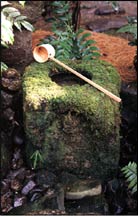

Chanoyu “hot water for tea” is a metonymy. It signifies a specific cultural sphere, developed from drinking matcha (powdered tea) that provides refreshment to body and soul. First introduced from China to Japan as a meditative aid for Zen monks, the tea-drinking habit evolved into a highly sophisticated and multifaceted art during the sixteenth century. True to the Buddhist teaching of finding dharma (Sanskrit: “the Buddha nature”) in every sentient being, the basic philosophy of chanoyu was class-defying and was, therefore, practiced not only by monks but also by warriors and merchants.
Principles
The unique cultural sphere of chanoyu is founded on four principles -- wa (harmony), kei (respect), sei (purity), and jaku (tranquility). Each principle is expressed through the formal styles, the gestures, the selected objects, and the holistic tearoom environment prepared for one specific time, place, and occasion of meeting with the guest for tea. Yet, it is a process enacted through time that weaves the four principles together to create this sphere. Culture, in this sense, is not a static framework of reference but a field where the process of cultivation takes place.
Process
For example, a tearoom is a physical representation of this cultural sphere. In its traditional format, it is a vacant space with no ornamentation. The host of the tea gathering, thus, prepares everything in advance to “set the stage.” Purification of all elements that enters the world of tea, including the garden with the roji, the tearoom, and the tea utensils, is the most important part of preparation. The manners, rules, and formalism in gesture that are visible in chanoyu can manifest themselves with a ceaseless flow only when profound attention to details has been paid by the host to prepare his/her mind for the occasion. To be prepared is to pay respect to the guest, and when the host meets the guest who as respectfully partakes in the occasion, the harmonious communication between them is generated reciprocally.
However, the stage for a tea gathering is planned, designed, and enjoyed only to be dismantled after its fruition. The end of the occasion brings a bittersweet moment to both the guest and the host. The gathering is over; the guest leaves the tearoom. The host now sits alone in the tearoom, contemplating and appreciating the shared moment that s/he just experienced. While the host starts to clean the room, the empty space is suffused with lingering warmth generated by human interaction and with tranquility that reflects the passing of time.
Continuity
The sphere of chanoyu, then, is characteristically temporal. It is this temporal nature that maintains a perpetual cycle of beginning, ending, and reviving itself. In each form of its manifestation, chanoyu cultivates creativity reflective of time and space. If using Korean daily utensils held an aesthetic relevance to the sixteenth century tea master Sen Rikyû, designing metal tea utensils in the flavor of the Bauhaus may hold as much relevance to a contemporary artist. The creation here involves cultivating new value by taking something that holds certain significance in one context and placing it in a different frame of time and space. The cultural sphere of chanoyu, thus, remains always open.
Chanoyu may be described as an intellectual game requiring intense creative faculties. It is fine to put it to use as a polestar for human life, and it is also fine to enjoy it as a conceptual art form. This is precisely why chanoyu can constitute a way of life that endures through changing times.
- Masakazu Izumi
Copyright © 2002 Asia Society

